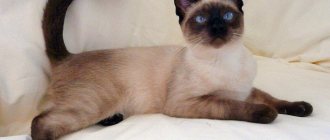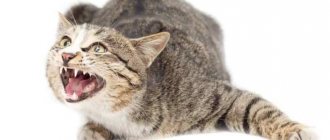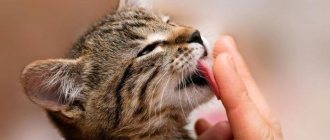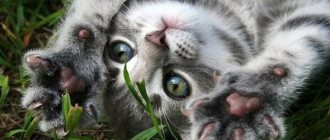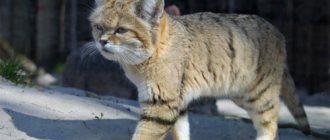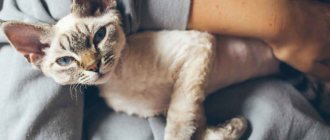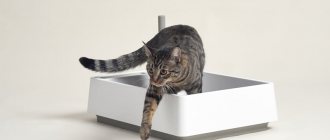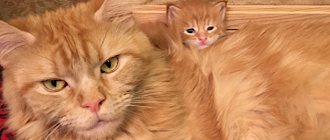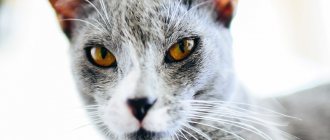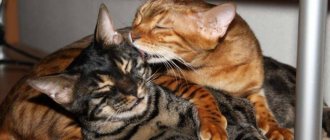Learning to understand a cat by its tail
The main expression of a cat's desires and moods is the tail . When a cat greets you with its tail raised up and meowing softly, it means that it is happy to see you and wants to be petted. If the cat's tail is shaking at this time, she is telling you that she misses you very much.
When a cat, waving its raised tail, looks intently into your eyes, this is a signal that it is unhappy and angry with you. Then leave her alone.
Do you see how the cat, turning away from you, hits the floor with its tail? This is how she shows her character and says that she is offended by you. In addition, she can demonstratively sit between you and the computer or between you and your guests.
When another cat encroaches on your pet’s territory or food, she growls and hisses, arching her back and raising her loose tail. This means readiness for defense or offense.
The kitten does not go into the litter box - reasons
If you do not want to face “toilet problems”, the kitten’s tray must be prepared in advance. Fine sand or sawdust intended for kittens is used as filler.
If the kitten does not go to the litter box, rule out the following reasons:
- The tray is unstable.
- The filler injures the paws.
- The litter or tray has a strong, unpleasant odor.
- Dirty filler.
- In some cases, cats ignore dark and red colored elbows.
Cats naturally have excellent balance, but instinctively avoid being in vulnerable positions. If the tray is not secure, the kitten will feel insecure. In addition, the cat confidently balances only in a standing position, and to go to the toilet she needs to squat down.
Note! A layer of litter that is too thick gives the kitten a feeling of insecurity because it weighs down its paws.
To accustom kittens to the tray, special litters are produced that have an attractive smell and a fine fraction. The litter particles for kittens do not have sharp corners, which reduces discomfort when visiting the litter box. Manufacturers usually offer silicone baby fillers that absorb moisture and odor well. Some cat breeds have very sensitive skin and are uncomfortable stepping on even baby litter.
If you notice that the kitten categorically refuses to go into the litter box after the first visit, most likely the reason is pain and discomfort. In this case, it is recommended to cover the tray with an absorbent diaper.
Low-quality fillers are made from waste construction materials and may have sharp edges and a pungent odor. Keep in mind that your pet's sense of smell is much more sensitive than yours. If you smell sand, it will be distinct and irritating to your kitten. Cats instinctively avoid places with a strong odor because they associate them with vulnerability.
Cats are clean by nature, which is why they bury their feces in the ground. According to generally accepted rules, adult cats have their litter box cleaned once a day. With a kitten, the situation is a little more complicated, since when searching for a litter box, he is guided by the smell.
Tip: to leave a guide for the kitten, you need to take some moisture-absorbing wipes and blot the urine with it. A piece of diaper that smells like urine should be placed on the bottom of the tray and sprinkled with a thin layer of filler.
As you know, cats can distinguish some colors, but they associate gray, red and black with the abyss. Simply put, if the litter box is the wrong color, your kitten may associate it with a hole in the floor. If you have already bought a tray of the wrong color, it is easier to accustom the kitten to the diaper.
Constipation, diarrhea and other gastrointestinal problems
In the first days of life in a new home, a kitten may experience problems with the functioning of the gastrointestinal tract. To avoid problems, do not switch the kitten to a new food during the adaptation period. To reduce stress, it is recommended to maintain your usual feeding and activity schedule.
Note! If you pick up a kitten on the street, you naturally will not be able to maintain your usual feeding method and schedule. With a high probability, on the very first day, due to a sudden change in diet, the kitten will begin to have diarrhea or constipation.
In the case of diarrhea, the kitten will physically not be able to restrain the urge to have a bowel movement and make it to the litter box. Under no circumstances should you punish your child for peeing in the wrong place. If constipated, the kitten will not be able to empty its bowels, despite an active and distinct urge.
The baby will climb into the tray, dig for filler, spin, scream loudly, sit down, but will never achieve results. To quickly alleviate your pet's condition, you can use Duphalac or flaxseed oil, which is added to food.
What do a cat's eyes say?
When a cat's eyes are wide open, it means that she is showing interest in some object or person. If a cat looks into your eyes, this is a sign that it wants to communicate with you, and its blinking while stroking is an expression of the highest bliss. At the same time, having released her claws, she can move her paws. Be patient, if this behavior causes you minor pain, do not drive the cat away. In this way, your pet identifies you with its mother.
A cat's half-closed eyes indicate that she feels peaceful. She looked away to the side - she was ready to obey you.
If the pupils of a cat's eyes are dilated, it means that she is afraid of something and you should help her eliminate the cause of her fear. And when the pupils sharply constrict, expect aggressive behavior from your cat.
By instinct
To better understand the habits of your pet, it is recommended to trace the behavior of wild relatives in their natural environment. All cats, with the exception of lions, lead a solitary lifestyle, having at their disposal a certain territory with clearly defined boundaries and an established internal routine.
According to zoological descriptions:
- the territory belonging to each individual is divided into hunting grounds, secluded daytime beds and latrines;
- Obeying natural cleanliness, cats will never set up a “bedroom” or “dining room” next to the “toilet”;
- in addition to discharging natural needs, latrines serve as individual scent marks, constantly updated to control the boundaries of personal possessions;
- Mature males and females are especially active in marking territory during the period of sexual hunting;
- the cubs turn out to be still too weak and vulnerable, so the mother carefully monitors the cleanliness of the nest and constantly licks the babies, fighting off the smell that attracts predators and enemies;
- As the young grow older, they begin to move further and further from the nest, choosing their own places for the toilet.
Cat facial language
A cat’s facial expressions can tell a lot. By moving its ears and whiskers, a cat informs you about many things. Ears pressed to the sides of the head indicate an aggressive mood or fear. When the ears twitch nervously, something is clearly irritating the cat, and she is thinking about how to react to the irritant. It's a good sign when the ears point forward. At this moment, the cat is in a relaxed state or is interested in something. He pulls his ears back and closes his eyes, expressing his impatience and request: “come on faster, I really want to.”
Cats can communicate with you through their whiskers and eyebrows. You see that the whiskers are directed forward - your cat has shown increased interest in something. For example, she is interested in a new toy and offers to play with it. She spread her mustache in different directions - she was calm. If the antennae are gathered in a bun and pressed against the cheeks, it means that something is bothering or frightening the cat; if they droop down, it means she is sad or sick.
What do we have to do?
If the kitten does not poop even for two days, action must be taken. The course of action largely depends on the cause of constipation.
- A massage will help a little kitten . The baby is placed on his back. After moistening a soft cloth or cotton pad with warm water, make longitudinal movements along the tummy from the chest to the tail. You must act carefully, gently, without pressure. The kitten should not experience discomfort. The duration of the massage is 2-3 minutes.
- A few drops of oil added to food twice a day will help relieve constipation. Olive, linseed, and Vaseline oil are suitable, but it is better to avoid sunflower oil, as it puts a powerful strain on the liver. You can use a syringe without a needle and drop the oil directly into your mouth. The daily dose is no more than half a teaspoon.
- Soap can help a kitten solve the problem of going to the toilet . A small piece is cut into a candle shape, then moistened with water and inserted into the animal’s anus. The procedure is unpleasant for the baby, so it is better to carry it out when he is sleeping. After a short time, the soap will begin to act, and the kitten will go away.
- After several days of constipation, it is acceptable to use an enema . The procedure will require a small syringe (10 ml). It is filled with lukewarm boiled water. The tip is lubricated with Vaseline or oil and carefully inserted into the animal’s anus. The insertion depth should be sufficient to prevent the liquid from spilling out. Carrying out manipulations alone is very inconvenient, given that the kitten is unlikely to lie still. You will need an assistant. But if you don’t have enough experience, it’s better to invite a veterinarian.
- Medicines for constipation must be prescribed by a doctor. It is not recommended to use them yourself. There is a whole group of medications suitable specifically for small kittens. These include, for example, “Lactusan” and “Duphalac”. These are mild products based on lactulose, a substance that causes a laxative effect.
You should not self-medicate. If the kitten does not walk at all for several days, it is time to contact a specialist.
Let's understand a cat by its sounds
At least 16 sounds are used by cats to communicate . Different cat breeds differ in their talkativeness. Siamese and Oriental cats love to chat with their owners the most. Rumbling and purring are characteristic of small cats. A cat's purring is a symbol of sympathy for its owners and good disposition. By purring, a cat shows its aggressiveness and tells you that it is ready to start a fight; Hissing shows fear and uncertainty about salvation. When a cat is contemplating fight or flight, it snorts and leans its body forward.
When does a kitten begin to feed on its own?
Upon reaching the age of one month, the digestive organs of a cat cub are fully formed and filled with beneficial bacteria.
The basis of nutrition is mother's milk, but it must be gradually supplemented with other products that facilitate the baby's transition to independent feeding.
The main food elements included in the list of possible complementary foods:
- thin porridge;
- pate from boiled meat, fish;
- lactic acid products.
Pet owners need to familiarize themselves with the main rules for introducing complementary foods for kittens:
- The transition should begin by giving warm milk. If the kitten does not understand how to lap, it is recommended to gently poke the pet’s muzzle into the drink. By licking himself, he will understand how to act.
- Then you can offer your pet thin porridge or meat pate.
There are also industrial feeds for feeding kittens. They can be started from 1 month.
At first, you will have to wipe the kitten after each meal. Gradually, he will learn to do everything carefully and independently clean his face of food debris.
Antigadin for cats: purchased and homemade products
What do cat poses tell you?
A terrifying pose: the cat, with its tail bent and its back arched, stretched its paws forward and stood on tiptoes. The fur stood on end, the ears pressed to the back of the head, the nose wrinkled, the fangs were exposed. This pose is accompanied by rumbling and snorting. If the cat is frightened, the nodules on its cheeks move and the fur bristles.
The pose of peace and bliss is expressed as follows: in a relaxed state, the animal lies on its back, opening its belly. In this case, the eyes are half-closed, the paws are spread out to the sides, the claws are hidden, and the pads are compressed and unclenched. This is how the cat speaks of complete trust in you, because its stomach is the most unprotected place. If, playfully, she suddenly hides her head in a secluded place, then she says: “look for me, I’m hiding.”
If, when stroking the lumbosacral region of the back, the cat falls on its front paws, lifts the back of its body and moves its tail to the side, this means that it wants intimacy with the cat.
You can find out more detailed information about how to determine the behavior of cats by their tail and what different poses mean in this article.
Preventing constipation and diarrhea
Another, no less unpleasant defecation disorder in kittens is diarrhea.
Before diagnosing your pet, you need to figure out how often kittens poop and whether it’s diarrhea at all. Many owners believe that if a kitten’s stool becomes liquid, then this is diarrhea. However, it is not.
Diarrhea is not only watery stool consistency, but also a frequent urge to defecate. An additional symptom may also be bloating.
The causes of diarrhea in an animal can be helminthic infestations, poor nutrition, infectious and inflammatory diseases. On a psychological level, early separation of a kitten from its mother can provoke diarrhea.
If a kitten has diarrhea, it is advisable not to feed it for about 12 hours, but to give it only water. By the way, he must drink. Not drinking water can lead to dehydration.
In this case, a sorbent such as Smecta or Enterosgel can be used as a medication.
If attacks of diarrhea no longer recur, then after 12 hours the pet can be fed. First, a little boiled rice or three-day (!) kefir is given. Fresh fermented milk products can only worsen the situation. The next day, boiled chicken meat, and so on, expanding the diet.
In any case, self-medication is not recommended for either people or animals. Therefore, if there are various disturbances in the process of relieving yourself in your little family member, you need to show him to the veterinarian.
You've already learned how often kittens poop and how to care for them. A loving owner should also take care of preventing problems with bowel movements. To do this you need:
- comb the animal regularly so that excess hair does not clog the intestines when licking;
- give kittens phytomines to cleanse the intestines;
- feed your pet a variety of foods, using foods rich in fiber;
- give space for your pet’s active life, which improves intestinal motility;
- contact your veterinarian in time.
